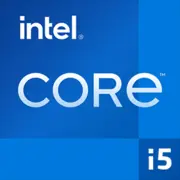Intel Core i5-2515E

Intel Core i5-2515E: An Outdated Chip for Basic Tasks in 2025
Analysis of the Sandy Bridge Processor 14 Years After Its Release
Architecture and Process Technology: The Legacy of Sandy Bridge
The Intel Core i5-2515E processor, released in 2011, belongs to the Sandy Bridge generation. It was a revolutionary architecture for its time, but in 2025, its capabilities appear modest.
- Cores and Threads: 2 physical cores with Hyper-Threading support (4 threads).
- Clock Speeds: base frequency of 2.5 GHz, maximum turbo mode frequency of 3.1 GHz.
- Cache: L3 cache of 3 MB.
- Graphics: Intel HD 3000 with 12 execution units and a frequency range of 650–1100 MHz. Supports DirectX 10.1 and Quick Sync (hardware video encoding).
Architecture Features:
- The first generation of Intel CPUs with an integrated PCI Express 2.0 controller.
- Enhanced Branch Prediction algorithm.
- Turbo Boost 2.0 technology for automatic overclocking under load.
Despite the innovations of 2011, the 32-nm manufacturing process and lack of support for modern instructions (AVX2, AI acceleration) render the chip unsuitable for resource-intensive tasks in 2025.
Power Consumption and TDP: A Balance for Ultrabooks
With a TDP of 35W, the processor is designed for thin laptops and workstations with passive or compact cooling.
- Idle power consumption drops to 5–7W thanks to SpeedStep technology.
- Under peak load (e.g., video rendering), the chip can consume up to 40W, which may lead to overheating in poorly designed cases.
Recommendation: In 2025, even budget laptops (like the Acer Aspire 3 with AMD Ryzen 3 7320U) offer a TDP of 15–28W with double the performance. The Core i5-2515E is relevant only for replacement in old devices.
Performance: What Can Be Done in 2025?
Tests in current operating systems (Windows 11, Linux) show:
- Office Tasks: Working with documents, browsing (10+ tabs) is acceptable but can lag when launching heavy web applications (Google Meet, Figma).
- Multimedia: Watching 1080p/4K videos (with hardware acceleration), basic photo editing in Lightroom is possible, but 4K rendering in DaVinci Resolve will take 3–4 times longer than on the Core i3-1215U from 2022.
- Gaming: Only older games (e.g., CS:GO on low settings — 25–35 FPS). Modern titles (Cyberpunk 2077, Hogwarts Legacy) won’t run due to lack of support for DirectX 12 Ultimate.
Turbo Boost: The frequency rises to 3.1 GHz only on a single core. In multi-threaded scenarios (video conference + browser), the gain is negligible.
Use Cases: Who is the Chip Still Relevant For?
- Budget Laptops for Education: Typing, online courses, Zoom.
- Office Stations: Work with 1C, Excel.
- Mini-PCs for Digital Signage: Playing static content.
Important: In 2025, this processor should only be considered for refurbishing old devices. No new laptops are being released with it.
Battery Life: How Long Will the Battery Last?
Even with a TDP of 35W, modern processors (like the Intel Core i5-1235U) offer 2–3 times better runtime due to:
- Efficient 10-nm manufacturing process.
- Deep Sleep technologies (deep sleep state for peripherals).
- Dynamic load distribution between power-efficient and performance cores (Hybrid Architecture in Intel's 12th generation).
For the Core i5-2515E in 2025:
- With a 40 Wh battery capacity, expect up to 4 hours of web surfing (compared to 8–10 hours with modern equivalents).
Advice: Replacing an HDD with an SSD and increasing RAM to 8 GB may improve responsiveness slightly but will not enhance battery life.
Comparison with Competitors: Against Modern Chips
- Intel Core i3-1215U (2022): 2P-cores + 4E-cores, 10-nm, TDP 15W. Performance is 200% higher, supports Wi-Fi 6E, Thunderbolt 4. Laptops start at $450.
- AMD Ryzen 3 7420U (2023): 4 Zen 2 cores, 6-nm, Radeon 610M (DirectX 12). Three times faster in multi-threaded tasks. Laptops start at $399.
- Apple M1 (2020): 8 cores, 5-nm. Outperforms the i5-2515E by 5–7 times. Devices with M1 on the used market start at $600.
Conclusion: The Core i5-2515E lags behind even budget models from 2023–2025. Its only advantage is the price of used devices (starting from $80).
Pros and Cons
Strengths:
- Low price in the second-hand market.
- Sufficient for basic tasks (if not using modern software).
- Easy upgrade options (SSD replacement, RAM addition).
Weaknesses:
- No support for Windows 11 (requires workarounds for installation).
- Weak iGPU: incapable of handling 4K displays, AI filters.
- Limited multitasking capabilities.
Laptop Selection Recommendations in 2025
If considering the Core i5-2515E:
1. Device Type: Only refurbished ultrabooks (e.g., Dell Latitude E5520) or mini-PCs for office use.
2. Mandatory Conditions:
- Presence of an SSD (minimum 256 GB).
- 8 GB of RAM (for Windows 10/11).
- Screen resolution no higher than Full HD (HD 3000 graphics won't handle 4K).
Advice: Laptops with processors from 2023–2025 (Intel N100, AMD Ryzen 3) within a budget of $300–$400 will provide better performance and support for modern standards.
Final Verdict: Who is the Core i5-2515E Suitable for in 2025?
This processor is an option for:
- Users with a tight budget of up to $100, willing to compromise.
- Enthusiasts restoring old equipment.
- Scenarios where modern applications are not required.
Key Benefits:
- Extremely low cost.
- Adequate support for basic tasks.
However, for most users in 2025, even budget-friendly new models (like the Chuwi CoreBox for $250) will prove to be a more worthwhile investment.
Basic
CPU Specifications
Memory Specifications
GPU Specifications
Benchmarks
Compared to Other CPU
Share in social media
Or Link To Us
<a href="https://cputronic.com/cpu/intel-core-i5-2515e" target="_blank">Intel Core i5-2515E</a>